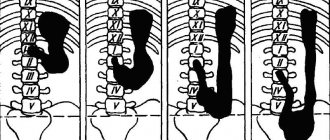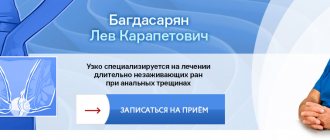Chronic appendicitis is a sluggish form of inflammation in the appendix. This organ itself is a vermiform appendix of the cecum, which, according to recent data, is related to the formation of immunity. However, the appendix is vulnerable, and often in the medical surgical practice of the Laboratory and Clinical Center in Yeisk one has to deal with a disease such as chronic appendicitis. This disease occurs against the background of once suffering an attack of acute appendicitis, which was not subjected to surgical treatment.
Symptoms of chronic appendicitis
If the acute form of appendicitis is a very common disease, then the chronic inflammatory process of this organ develops much less frequently precisely because in acute appendicitis, an appendectomy is most often performed - this appendix is removed. But this surgical method is not always used, therefore the development of appendicitis into a chronic form is a process of atrophic and sclerotic changes in this organ, as a result of which granulation tissue grows, scars and adhesions form, obliteration of the lumen develops and deformation of the appendix, which gradually fuses with surrounding organs and fabrics.
In medicine, chronic appendicitis is divided into three forms:
- Residual: develops after an acute attack, which without surgical intervention ended in recovery.
- Recurrent: characterized in that repeated attacks periodically appear, but the symptoms are not so acute, the clinical manifestations are smoothed out.
- Primary chronic: this form, unlike the previous two, develops without a primary acute attack, development occurs gradually.
As for symptoms, the following clinical picture is observed in chronic appendicitis:
- a feeling of discomfort and heaviness, dull aching pain in the right iliac region that occurs after physical activity or errors in eating;
- nausea, flatulence, constipation or diarrhea;
- the temperature in the evenings rises to low-grade fever;
- painful and frequent urination, pain during gynecological examination;
- pain during rectal examination.
Diagnostics
The appearance of signs of developing chronic appendicitis requires immediate contact with a gastroenterologist.
A sluggish process in the abdominal cavity does not exclude the development of dangerous complications. The most difficult of them are perforation (fraught with the entry of contents from the appendix into the abdominal cavity) and gangrene (rotting of the appendix). Both conditions lead to poisoning of the body and are characterized by a sharp deterioration in health. Chronic appendicitis has similar symptoms to diseases of the gastrointestinal tract and genitourinary system, so diagnosis is based on the use of techniques that allow differentiating the conditions.
Diagnosis of chronic appendicitis consists of collecting complaints from the patient, palpating the affected area, and prescribing a number of procedures:
- blood test data (leukocytes are often elevated);
- urine test (to rule out urinary system disease);
- radiography with contrast - the study determines the patency of the process;
- An important diagnostic method that helps determine chronic appendicitis is ultrasound. This is an informative and painless technique that shows the condition of the area under study, the presence of lesions, the structure of the walls of the organ;
- CT scan – to obtain detailed images, study the structure, shape and condition of tissues, and detect a tumor. Helps clarify the conclusion about chronic appendicitis and determine the necessary treatment technique.
Treatment
Operation
is considered the best effective method of treating chronic appendicitis. Intervention is indicated in the presence of adhesions, scars, and severe pain. Today, the source of inflammation is removed using a minimally invasive method, in which the patient recovers in a short time. The doctor, despite the small incisions, sees the full picture of what is happening in the abdominal cavity. Laparoscopic treatment of chronic appendicitis allows for high-quality work, leaving virtually no marks on the skin after the scars have healed.
In case of contraindications to laparoscopy (for example, due to complications), a classical operation is recommended. This is necessary for a detailed examination of the abdominal cavity and removal of all foci of infection. After the intervention, antibiotics are taken, and the patient is observed until complete recovery.
It happens that the diagnosis of chronic appendicitis shows that there are no clear indications for surgery. The patient may not be bothered by anything, and then they resort to conservative treatment. Antispasmodics and other symptomatic therapy are prescribed.
Causes of appendicitis
Inflammation of the appendix is caused by opportunistic microorganisms. When examining the affected tissue of the inflamed appendix, Escherichia coli, enterococcus, streptococcus, Staphylococcus aureus and anaerobic microorganisms are most often found. Pathogenic microorganisms penetrate the wall of the appendix from its lumen.
Doctors identify factors that provoke inflammation of the appendix:
- inflammatory process in the intestines;
- deformation of the appendix, in which there is a violation of blood circulation in the walls of the organ, which leads to necrosis of the appendix tissue;
- blockage of the appendix - fecal stones, neoplasms, foreign bodies and accumulation of parasites can close the lumen of the appendix. At the site of the blockage, microbes begin to actively multiply, causing inflammation.
Recommendations
If you experience abdominal pain, seek medical attention immediately. If pain occurs at night or on weekends, call an ambulance. Do not take any painkillers other than no-shpa, as this can erase the clinical picture of an acute disease, which leads to late diagnosis and complications.
Remember, the sooner you contact a specialist, the lower the risk of complications. If treated in a timely manner, surgical treatment is limited to appendectomy only (removal of the appendix).
If you have a choice, then contact a medical institution that can perform a laparoscopic appendectomy. But even if the clinic does not have equipment for laparoscopic operations, an experienced surgeon can perform an appendectomy from a small incision (3–4 cm) followed by a cosmetic intradermal suture.
It happens that in the presence of a clinical picture of acute appendicitis, entering the abdomen, the surgeon sees an unchanged appendix. In such cases, he must check the entire abdominal cavity, identify the cause of the disease and eliminate it. That is why an experienced, highly qualified surgeon is needed.
How to remove appendicitis during laparoscopy
Patients are often interested in what anesthesia is used to remove appendicitis. Surgery is performed under general anesthesia. At the beginning of the operation, the patient is given anesthesia. After antiseptic treatment of the skin in the area of the operation, in the anterior abdominal wall (in the pubic area and right hypochondrium), the surgeon makes three small incisions. The laparoscope is inserted through the first incision, which is located just above the navel. Through other holes, special instruments are inserted to hold the appendix. Next, the surgeon removes the inflamed appendage and removes it from the abdominal cavity.
This is followed by suturing. Typically, absorbable suture material is used and does not require subsequent removal.
Diagnosis of appendicitis
Determining the diagnosis of acute appendicitis in a normal situation does not present any difficulties. However, the individual characteristics of the location of the appendix and the varying intensity of inflammation can make diagnosing the disease difficult.
Symptoms of appendicitis in adults may be similar to other diseases affecting the gastrointestinal tract (renal colic, adnexitis, acute cholecystitis or pancreatitis, perforating ulcer), as well as some other diseases (inflammation of the right lobe of the lung, herpes zoster). Symptoms of appendicitis in women are often confused with ectopic pregnancy and other gynecological pathologies.
To diagnose a disease, the doctor interviews and carefully examines the patient.
For a more accurate determination, additional studies are prescribed:
- Clinical analysis of blood and urine.
- Ultrasound or CT scan of the abdominal organs.
- Laparoscopy.
What is an appendectomy?
Appendectomy is a surgical operation to remove the appendix.
The appendix is a vermiform appendage that is an appendage of the cecum. It is believed that the appendix stimulates the immune system and improves the body's defense resources. The appendix is a cylindrical organ, hollow inside and without a through passage. The average length of the appendix is 8–10 cm. Appendicitis is a disease associated with inflammation of the appendix. It can occur in acute or chronic form. In chronic appendicitis, appendectomy is performed routinely. An acute form of inflammation of the appendix requires timely surgical intervention.
Appendicitis in women: causes, symptoms, diagnosis
24.09.2019
Appendicitis occurs much more often in women This is due to the structural features of the body. The inflammatory process often begins during menstruation and is manifested by abdominal , nausea and vomiting. Every woman should know the symptoms of inflammation of appendicitis - this will help her avoid complications.
Reasons for appearance
The appendix is a lymphoid organ up to 5 cm long. It provides immune protection to the digestive organs. Most often, appendicitis occurs in women aged 20 to 40 years.
The causes of the disease may be the following:
- displacement of the appendix as a result of its compression by the abdominal organs. This situation occurs during pregnancy ;
- blockage of the organ with small debris (for example, seeds);
- clogging of the lumen with feces;
- poor nutrition;
- transfer of infection from the pelvic organs;
- inflammation of the lymphoid tissue in the appendix;
- infection through the blood or intestines ;
- individual structural features of the appendix.
To avoid the disease, women should:
- Healthy food. Foods high in fiber help eliminate the problem of constipation and improve digestion;
- support immunity . Taking vitamins, physical activity, hardening - protect the body from inflammatory diseases and prevent infection from getting into the appendix;
- fight allergies , which can greatly reduce immunity ;
- do not expose the body to emotional tension and stress.
First symptoms
The most common sign of appendicitis abdominal pain . It can intensify during movement, spread throughout the abdomen and radiate to the leg. The pain is pressing and pulling in nature, often moving from the right side to the left, and vice versa.
After some time, the woman begins to feel a low-grade fever. Typically it varies from 37 to 38 degrees. Feeling gradually worsens, nausea and vomiting appear.
Due to the fact that food is no longer digested normally, a person begins to experience diarrhea or constipation . of urination also increases significantly .
The first symptoms of appendicitis most often occur against the background of a normal condition.
Dangerous manifestations of appendicitis
Despite the fact that appendicitis is a common disease, it is not always possible to diagnose it yourself. Sometimes the symptoms of a disease manifest themselves differently and are interpreted incorrectly by a person.
A disease that is accompanied by complications can be recognized by the following signs:
- vomiting mixed with bile is a symptom of blockage of the bile ducts;
- black feces indicate the presence of blood ;
- increased gas formation - signals inflammation of the pancreas ;
- prolonged absence of menstruation .
The danger of these symptoms is that they can lead to serious complications and rupture of the appendix.
Diagnostics
As soon as a person has the first symptoms of the disease, you need to call a doctor .
Under no circumstances should you:
- drink water;
- carry out active movements;
- reduce the temperature with antipyretic drugs;
- use painkillers.
To make sure that the pain is a consequence of appendicitis , you can diagnose the pathology by palpation.
a flat surface and bend her knees . After this, she should gently press her fingers on the right side of her abdomen . If the pain intensifies during palpation, then the appendage is inflamed.
You can also detect inflammation of the appendix by loud coughing. If during a cough a woman feels pain in the area of the right ilium , this indicates confirmation of the diagnosis.
Appendectomy
It is impossible to cure inflammation of the appendix; the appendix is removed surgically .
There are two types of operations:
- emergency - carried out immediately after arrival at the hospital . The surgeon makes an incision on the right side of the peritoneum. After removing the appendage, a small scar remains on the body;
- planned - carried out a few hours after admission to the hospital . Elective surgery is performed on patients with any contraindications.
Further stay in the hospital is no more than 7-10 days. Rehabilitation after removal lasts until the doctor removes the stitches.
During this period, it is important to follow some recommendations:
- refuse to visit the bathhouse;
- do not expose the body to physical stress;
- do not lift weights weighing more than 2 kg;
- stick to a diet ;
- do not drink alcoholic beverages.
It is important for women to normalize their bowel movements, so they should drink as much clean water as possible.
Published in Surgery Premium Clinic








